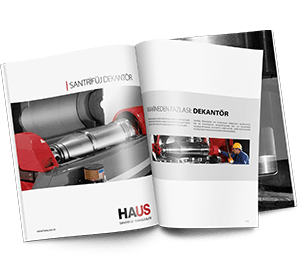Today, the importance of hygiene in the food and pharmaceutical industries is emphasized more than ever. CIP (Cleaning In Place) systems play a critical role in raising hygiene standards and increasing efficiency in production processes.
In various sectoral facilities, it is essential to reduce planned and unplanned maintenance as much as possible in order to make active use of machine operation time. Among the unplanned failures, one of the criteria that can be easily prevented is the inoperability or inadequate performance of the machine due to pollution. For this purpose, centrifugal separators that are likely to be contaminated are subjected to cleaning-in-place (also known as CIP) operations in the middle and/or at the end of the day to chemically clean the internal volume of the machine. The cleaning-in-place function is realized by mixing caustic and nitric acid solutions with hot water in special ratios depending on the need, and feeding them at a rate 10 percent above the separator hydraulic capacity.
Cleaning in place (CIP) is widely applied in many industries to effectively clean production equipment without the need for any disassembly/assembly thanks to the clean-in-place function. CIP systems ensure consistent and repeatable cleaning and allow cleaning operations to be performed and reported efficiently. Especially for food products, the cleanliness and hygiene of the production equipment that performs the operation is a critical element in ensuring a reliable end product.
The CIP system has become an indispensable part of modern production facilities. It offers an ideal solution to meet cleaning and hygiene standards, increase operational efficiency and reduce employee workload. The CIP system can be considered as the key to industrial hygiene, significantly improving food safety and quality.
CIP System in HAUS Decanter Centrifuges and Separators
HAUS, as a company with an approved R&D and Innovation Center, carries out the design and material selection of food decanters and separators in accordance with hygiene standards within the framework of EHEDG (European Hygienic Engineering and Design Group) membership. Dedicated to continuous improvement and development, HAUS pays special attention to elements such as the CIP system, which are critical in maintaining cleanliness conditions, and constantly monitors the hygienic status of the process flow.
In HAUS decanters, CIP systems are designed to fully meet the hygienic design requirements and the hazard analysis performed within the scope of HACCP to prevent the contamination of food with hazards that may affect the quality and safety of food.
What is Hygienic Design?
Hygienic design refers to the design of machines for easy cleaning and the selection of materials used in their production.
Smooth and Gapless Designs for Reliable Cleanability
HAUS F series decanters use high quality stainless material on the surfaces in contact with the product. Another issue that is more important than the quality of the material is the surface smoothness. The smoother the surface, the higher the efficiency of the CIP system. HAUS F series decanter parts can be produced with Ra = 0.8 µm and Ra = 0.4 µm surface roughness according to the contact with food and polishing can be applied on the auger group and bowl groups.


HAUS CIP Design
The working principle of HAUS CIP system consists of two parts: drum internal washing and drum external washing. The design of HAUS F series decanters aim for minimum consumption and maximum cleaning. The CIP cleaning cycle adjusts the drum speed and the appropriate amount of cleaning agent based on our algorithms and coverage tests with 70 years of experience.

Coverage test is a method used to measure the efficiency of the CIP system after a powder made of vitamins is mixed with water and sprayed on the application areas. Although this substance made of vitamins is very difficult to see after cleaning, it shines with UV rays and shows the cleaning efficiency and allows us to better determine the type of nozzle used in the CIP system, the application pressure and the placement of the nozzles.

COVERAGE TEST
The Importance of the Snap-On Hopper
As it is known, the importance of hygiene is very high in high quality olive oil plants where there is a great interest today. Therefore, at the end of the day and even at intermediate times in these facilities, all machines are cleaned precisely. As HAUS, we attach importance to this and in order to make cleaning easier and faster, a suitable design has been made in the lid opening system.
With the plug-in chamber design, the gasket used between the chamber is canceled and hygienic design is emphasized. The connection between the chassis and the hopper offers an advantage to the customer by contributing to the cleaning speed with the easy-to-open locking method. In addition, since the upper chamber has the ability to open on both sides, the advantage of flexible machine positioning/projecting is provided.
CIP System in HAUS Separators
In separators without a cleaning-in-place (CIP) function, the machine needs to be disassembled and all internal components must be cleaned with caustic water and rinsed with water by stopping production approximately every 2 to 4 days, depending on the type of olive, capacity, olive efficiency, and working parameters. This process causes production to stop, resulting not only in a loss of time but also in a decrease in the daily capacity of the facility and, in some cases, occupational accidents. The CIP system used in olive oil separators produced by HAUS is integrated into the separator and can operate without the need for any transport, mechanical, or electrical connections. The cleaning-in-place function, which is controlled via the separator panel and can be easily started and stopped by the operator thanks to high automation, ensures that the machine and equipment always remain clean. Thanks to the embedded and effective operation of the cleaning-in-place function in the machine panel, all cleaning steps can be completed in approximately 50 minutes daily. Compared to traditional methods, this provides a time savings of 3 to 4 times.


DISC INNER SURFACE BEFORE CIP OPERATION DISC INNER SURFACE AFTER CIP OPERATION
 .
. 
SEPARATOR PARTS BEFORE CIP OPERATION SEPARATOR PARTS AFTER CIP OPERATION
Thanks to the HAUS CIP system, hot water required for cleaning and rinsing needs can be prepared 30 minutes before the product processing is completed with the help of the heating element located on the resting tank. By adding an appropriate amount of hydrogen peroxide (caustic) into the CIP tank, the cleaning solution can be prepared while the olive oil separation is still ongoing. This minimizes time loss. When moving to the cleaning-in-place steps, the valves on the machine can be easily set to CIP positions, and the cleaning processes can be initiated from the separator panel. To achieve maximum efficiency from the cleaning, the high-capacity centrifugal pump positioned on the machine and the flow equipment on the line allow effective cleaning of all blind spots by reaching every part of the separator. After the CIP processes are completed, the separator can shut down itself, and since no operations are needed during the shutdown, the facility can be closed.
How to Switch the Separator to CIP Mode?
The installation connections of HAUS separators are designed to enable quick switching to CIP mode. Before switching to CIP mode, it is checked whether the CIP solution is ready. Once the solution reaches the desired temperature, the necessary valve connections for transitioning from product processing mode to CIP mode are changed. In the visual shared below, the valves shown in red should be closed, and the valves shown in green should be open. Then, by starting the CIP mode via the HMI screen, the machine is automatically cleaned by the program.








